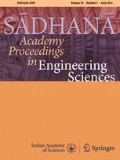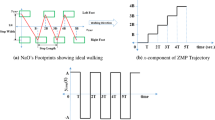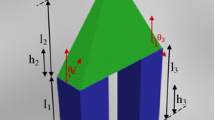Abstract
This paper deals with multi-objective optimization in gait planning of a 7-dof biped robot during its double support phase, while ascending and descending some staircases. For determining dynamic balance margin of the robot in terms of zero-moment point, its double support phase has been assumed to be consisting of two single support phases on non-coincidental parallel surfaces. Thus, dynamic balance margin of the biped robot during its double support phase is obtained by using a virtual zero-moment point of the system. Moreover, a smooth transition from single to double support phases in a cycle is to be maintained for the walking robots. Two contrasting objectives, namely power consumption and dynamic balance margin have been considered during optimization. Pareto-optimal fronts of solutions are obtained using genetic algorithm and particle swarm optimization algorithm, separately. To the best of the authors’ knowledge, it is the first attempt to solve multi-objective optimization problem in double support phase of a biped robot.














Similar content being viewed by others
References
Clerc M and Kennedy J 2002 The particle swarm-explosion, stability and convergence in a multi-dimensional complex space. IEEE Trans. on Evolutionary Computation 6: 58–78
Das M and Dehuri S 2011 Some studies on particle swarm optimisation for single and multi-objective problems; Integration of Swarm Intelligence and Artificial Neutral Network (Machine Perception and Artificial Intelligence), Dehuri, S., Cho, S.B., Ghosh, S. (eds.), World Scientific Publishing Company; Singapore, First edition, January, pp. 253–254
Deb K, Pratap A, Agarwal S, and Meyarivan T 2002 A fast and elitist multiobjective genetic algorithm: NSGA-II. IEEE Trans. Evolutionary Computation 6(2): 182–197
Eberhert R C, Simpson P, and Dobbins R 1996 Computational intelligence PC tools: Dalian, San Diego, USA: Academic Press, Ch 6, pp. 212–226
Fu K S, Gonzalez R C, and Lee C S G 1987 Robotics: Control, Sensing, Vision, and Intelligence. McGraw-Hill Inc.
Goldberg D E 1989 Genetic Algorithm in Search Optimization, and Machine Learning, Addison-Wesley, Reading, Massachusetts, USA
Hemami H and Farnsworth R L 1997 Postural and gait stability of a planar five-link biped by simulation. IEEE Trans. Automatic Control 22(3): 452–458
Holland J H 1975 Adaptation in Natural and Artificial Systems, The University of Michigan Press, Ann Arbor, MI, USA
Ito S and Kawasaki H 2000 A standing posture control based on ground reaction force. Proc. of IEEE/RSJ Intl. Conf. on Intelligent Robotics and Systems, pp 1340–1345
Ito S, Amano S, Sasaki M, and Kulvanit P 2008 A ZMP feedback control for biped balance and its application to in-place lateral stepping motion. J. Comput. 3(8): 23–31
Jamshidi N and Rostami M 2008 Gait optimization of biped robot during double support phase by pure dynamic synthesis. Am. J. Appl. Sci. 5(9): 1175–1181
Kennedy J and Eberhart R 1995 Particle swarm optimization. Proc. of IEEE Intl. Conf. on Neural Networks, Perth, Australia, pp. 1942–1948
Li Q, Takanishi A, and Kato I 1991 A biped walking robot having a ZMP measurement system using universal force-moment sensors, Proc. of IEEE/RSJ Intl. Workshop on Intelligent Robots and Systems IROS ’91. Nov. 3–5, Osaka, Japan, pp. 1568–1573
Lin J, Chang J, Lyu S M, Wang S W, and Lin Y W 2010 Locomotion control of a biped robot for stair-climbing by fuzzy stabilization tuning approach. Proc. of IEEE Multi-Conference on Systems and Control. Yokohama, Japan, September 8–10, pp. 1590–1595
Mitobe K, Mori N, and Nasu Y 1997 Control of a biped walking robot during the double support phase. Autonomous Robots 4: 287–296
Nishii J, Ogawa K, and Suzuki R 1998 The Optimal gait pattern in hexapods based on energetic efficiency, Proc. of 3 rd Intl Symposium on Artificial life and Robotics, 1, pp. 106–109
Pratihar D K 2008 Soft Computing, Narosa Publishing House, New Delhi, India
Raquel C R and Naval P C J. 2005 An effective use of crowding distance in multi-objective particle swarm optimization. Proc. of Genetic and Evolutionary Computing Conf. 2005(GECCO ’05), pp. 257–264, June 25–29, Washington DC, USA
Sardain P and Bessonnet G 2004 Forces acting on a biped robot. Centre of Pressure-Zero Moment Point. IEEE Trans. on Systems, Man and Cybernetics-Part A: Systems and Humans 34 (5): 630–637
Shi Y and Eberhart R C 1999 Empirical study of particle swarm optimization. Proc. of IEEE Intl. Congress on Evolutionary Computation, 3, Washington DC, USA, 101–106
Vukobratovic M, Frank A A, and Juricic D 1970 On the stability of biped locomotion. IEEE Trans. Biomedical Eng. 17(1): 25–36
Vundavilli P R and Pratihar D K 2010 Dynamically balanced optimal gaits of a ditch-crossing biped robot. Robotics and Autonomous Syst 58: 349–361
Vundavilli P R and Pratihar D K 2011a Balanced gait generations of a two-legged robot on sloping surface. Sadhana 36(4): 525–550
Vundavilli P R and Pratihar D K 2011b Near-optimal gait generations of a two-legged robot on rough terrains using soft computing. Robotics and Computer-Integrated Manufacturing 27: 521–530
Vundavilli P R, Sahu S K, and Pratihar D K 2007a Dynamically balanced ascending and descending gaits of a two-legged robot. Int. J. Humanoid Robotics 4(4): 717–751
Vundavilli P R, Sahu S K, and Pratihar D K 2007b Online dynamically balanced ascending and descending gait generation of a biped robot using soft computing. Int. J. Humanoid Robotics 4(4): 777–814
Wieber P B 2002 On the stability of walking systems. Proc. of Intl. Workshop on Humanoid and Human Friendly Robotics. Tsukuba, Japan, pp 53–59
www.particleswarm.info, accessed from January to July 2010
Acknowledgements
The authors thank All India Council of Technical Education (AICTE), Govt. of India, for supporting this study and Mr. Ashutosh Kumar Misra, for providing some useful suggestions.
Author information
Authors and Affiliations
Corresponding author
Appendix A
Appendix A
1.1 Expressions for Joint Torques
The equations of n joint torques can be written as follows (Fu et al 1987):
where D i k denotes inertia terms, h i k m represents the Coriolis and centrifugal terms, and C i indicates information of the gravity terms.
Rights and permissions
About this article
Cite this article
RAJENDRA, R., PRATIHAR, D.K. Analysis of double support phase of biped robot and multi-objective optimization using genetic algorithm and particle swarm optimization algorithm. Sadhana 40, 549–575 (2015). https://doi.org/10.1007/s12046-014-0327-5
Received:
Revised:
Accepted:
Published:
Issue Date:
DOI: https://doi.org/10.1007/s12046-014-0327-5




